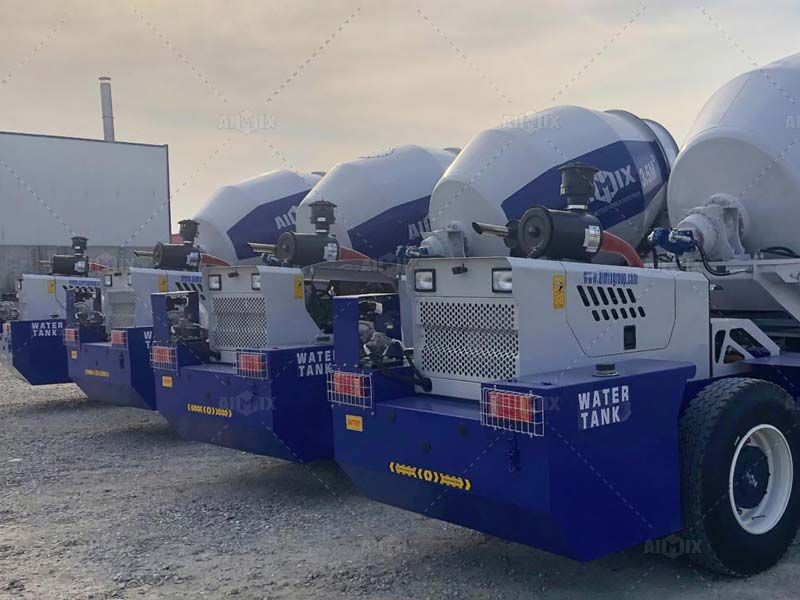Self Loading Concrete Mixers - How To Maintain Them In Good Condition?
- By AIMIX Group
- •
- 18 Mar, 2024
- •

Self-loading concrete mixers are indispensable equipment in the construction industry, offering convenience and efficiency in concrete mixing and transportation. To ensure their optimal performance and longevity, proper maintenance is essential. Let's delve into the intricacies of maintaining self-loading concrete mixers in good condition.
I. Understanding Self Loading Concrete Mixers
A. Introduction to self loading concrete mixers
Self-loading concrete mixers are innovative machines designed to combine the functions of a concrete mixer and a loader into a single unit. They are equipped with a self-loading feature that enables them to load raw materials, mix concrete, and transport it to the desired location, eliminating the need for additional equipment or manual labor.
B. Components of self loading concrete mixers
Self-loading concrete mixers consist of various components, each playing a crucial role in their operation. These include the loading bucket, mixing drum, hydraulic system, control panel, and chassis. Understanding the function and maintenance requirements of each component is vital for ensuring the overall performance and reliability of the mixer.
II. Maintenance Tips for Self Loading Concrete Mixers
A. Regular cleaning and inspection
Regular cleaning and inspection are fundamental maintenance practices for self loading mobile concrete mixer. After each use, the mixer should be thoroughly cleaned to remove any concrete residue or debris that may accumulate in the mixing drum or on other components. Additionally, conducting routine inspections allows operators to identify and address any potential issues or wear and tear before they escalate into major problems.
B. Lubrication and greasing
Proper lubrication and greasing are essential for ensuring the smooth operation of self-loading concrete mixers. All moving parts, such as bearings, gears, and hydraulic components, should be adequately lubricated to reduce friction and prevent premature wear. Using the appropriate lubricants and following the manufacturer's recommendations for lubrication intervals are crucial steps in maintaining the mixer's performance and extending its service life.
C. Preventive maintenance schedule
Implementing a preventive maintenance schedule is key to keeping self-loading concrete mixers in good condition. This schedule should include regular maintenance tasks such as checking fluid levels, inspecting hoses and connectors, testing safety features, and verifying calibration settings. By adhering to a structured maintenance regimen, operators can proactively identify and address potential issues, minimize downtime, and maximize the efficiency and reliability of the mixer.
In conclusion, maintaining self-loading concrete mixers in good condition requires diligence, attention to detail, and adherence to a structured maintenance regimen. By understanding the components of the self loading concrete mixer machine and implementing proper maintenance practices such as regular cleaning, lubrication, and preventive maintenance, operators can ensure optimal performance, longevity, and reliability, ultimately enhancing productivity and minimizing downtime on construction sites.
AIMIX Global Products
- Stone Crusher
- rock crusher
- Limestone Crusher
- granite crusher
- quartz crusher
- quarry crusher
- Gravel Crusher
- mobile crusher plant
- stone crusher plant
- crushing plant
- mobile impact crusher
- mobile jaw crusher
- mobile crusher
- mobile cone crusher
- mini self loading concrete mixer
- self loading mobile concrete mixture
- self loading concrete mixer for sale
- self loading concrete mixer truck
- self loading cement mixer
- asphalt plant for sale
- asphalt mobile plant
- drum mix plant
- mini asphalt plants for sale
- portable asphalt mixing plant
- asphalt hot mix plant
- batching plant manufacturers
- concrete plant for sale
- small concrete batch plant
- mini cement plant
- mobile concrete plant
- portable batch plant
- stationary concrete batching plant
- ready mix concrete plant
- how does a batching plant work
- concrete batching plant price
- ready mix concrete plant in bangladesh
- concrete batching plant in uae
- concrete batching plant indonesia
- concrete batching plant malaysia
- concrete batching plant for sale australia
- concrete batching plant Philippines
- concrete batching plant for sale UK
- concrete batching plant in saudi arabia
- concrete pump
- concrete mixer with pump
- mobile concrete pump
- portable concrete pump
- concrete trailer pump
- mini concrete pump
- small concrete pumps
- diesel concrete pump
- electric concrete pump
- hydraulic concrete pump
- dry mix mortar plant
- small dry mortar plant
- automatic dry mortar plant equipment
- big dry mortar plant
- dry mortar production line manufacturer
- dry mortar production line
- Tile adhesive manufacturing plant
